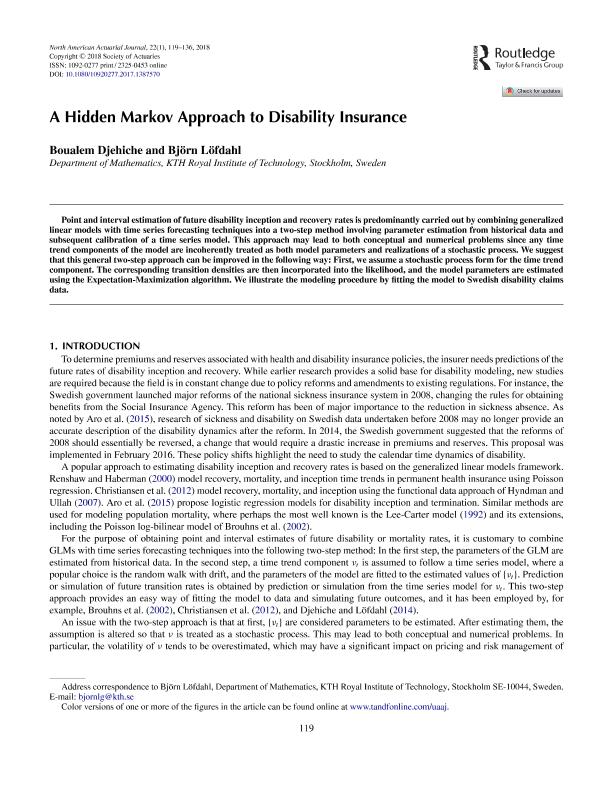A Hidden markov approach to disability insurance

Contenido multimedia no disponible por derechos de autor o por acceso restringido. Contacte con la institución para más información.
| Tag | 1 | 2 | Value |
|---|---|---|---|
| LDR | 00000cab a2200000 4500 | ||
| 001 | MAP20180017032 | ||
| 003 | MAP | ||
| 005 | 20180615131304.0 | ||
| 008 | 180606e20180301usa|||p |0|||b|eng d | ||
| 040 | $aMAP$bspa$dMAP | ||
| 084 | $a6 | ||
| 100 | $0MAPA20150002778$aDjehiche, Boualem | ||
| 245 | 1 | 2 | $aA Hidden markov approach to disability insurance$cBoualem Djehiche, Björn Löfdahl |
| 520 | $aPoint and interval estimation of future disability inception and recovery rates is predominantly carried out by combining generalized linear models with time series forecasting techniques into a two-step method involving parameter estimation from historical data and subsequent calibration of a time series model. This approach may lead to both conceptual and numerical problems since any time trend components of the model are incoherently treated as both model parameters and realizations of a stochastic process. We suggest that this general two-step approach can be improved in the following way: First, we assume a stochastic process form for the time trend component. The corresponding transition densities are then incorporated into the likelihood, and the model parameters are estimated using the Expectation-Maximization algorithm. We illustrate the modeling procedure by fitting the model to Swedish disability claims data | ||
| 650 | 4 | $0MAPA20080576783$aModelo de Markov | |
| 650 | 4 | $0MAPA20080562144$aDiscapacidad | |
| 650 | 4 | $0MAPA20080603793$aSeguro de incapacidad | |
| 650 | 4 | $0MAPA20080603120$aProcesos estocásticos | |
| 650 | 4 | $0MAPA20080602437$aMatemática del seguro | |
| 650 | 4 | $0MAPA20080597733$aModelos estadísticos | |
| 651 | 1 | $0MAPA20080637811$aSuecia | |
| 700 | 1 | $0MAPA20150005106$aLöfdahl, Björn | |
| 773 | 0 | $wMAP20077000239$tNorth American actuarial journal$dSchaumburg : Society of Actuaries, 1997-$x1092-0277$g05/03/2018 Tomo 22 Número 1 - 2018 , p. 119-136 |

